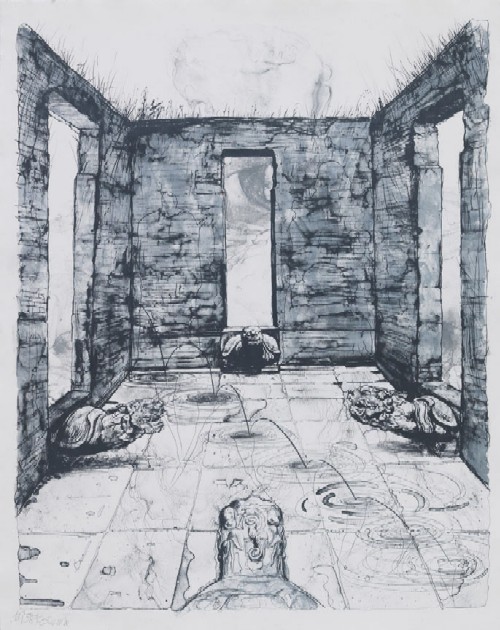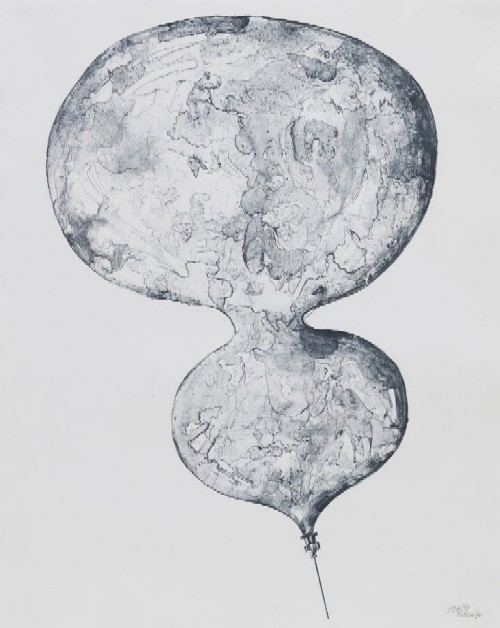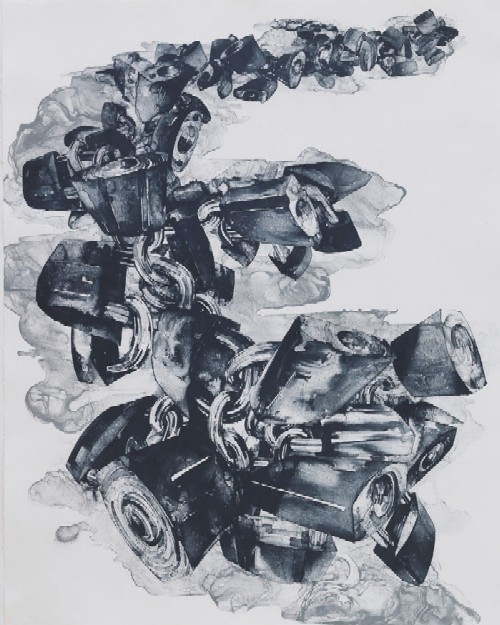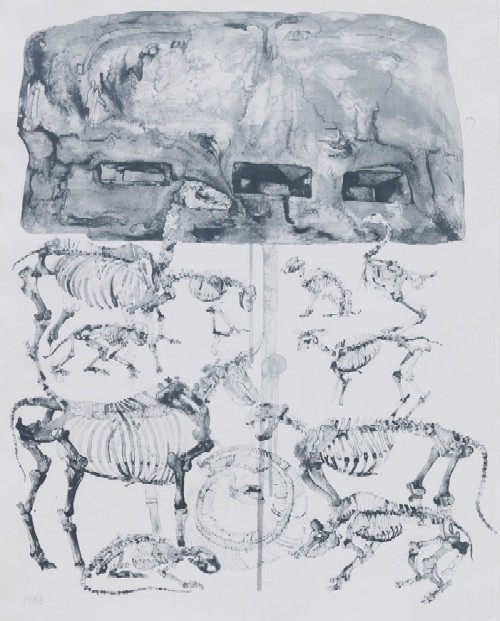Reviews & Articles
Qiu Zhijie: The Bridge, Nanjing, Under the Heaven
Hilary BINKS
at 7:48pm on 7th November 2008




Qiu Zhijie’s photographic self-portrait, "Tattoo I" (1997) has become one of the iconic images of contemporary Chinese art. The character “bu”, meaning “No”, is tattooed in red across his body and extends on the wall behind him, as if floating free. Exhibited at the "Between Past And Future: New Photography And Video From China" show at the Victoria and Albert Museum in 2005, Tattoo I shows Qiu’s interdisciplinary approach to art, specifically his interest in Chinese calligraphy and the possibility of integrating it with contemporary art forms. Furthermore, it expressed his idea that in a mass media age, "signs and codes have overpowered actual human beings, and our bodies have become merely their vehicles."
In the past 10 years, Qui Zhijie has proved himself to be one of the most creative and ground-breaking Chinese artists, exploring a wide variety of media including photography, video, painting, calligraphy, print making and performance art. Born in 1969 in Fujian, Qiu graduated in 1992 from the Printmaking Department of the Zhejiang Academy of Fine Arts (now the China Academy of Art) in Hangzhou, and currently lives and works as a full time artist in Beijing. His works, often fusing traditional Chinese calligraphy with video works, installation and performance art, have been featured in several major exhibitions of contemporary Chinese art, including most recently The Third Guangzhou Triennial at the Guangdong Museum of Art in 2008.
Qiu Zhijie’s latest project is a collection of 40 new unique and editioned works created for the Singapore Tyler Print Institute (STPI), 12 of which are displayed in the Hanart TZ Gallery exhibition. Established in 2002 under the guidance of the American master printer Kenneth E. Tyler, and supported by the Singapore Government, the STPI is recognized as the leading print-making studio in the world. For nearly 40 years in the USA, Tyler published major works by prominent international artists including Josef Albers, Anthony Caro, Helen Frankenthaler, David Hockney, Jasper Johns, Ray Lichtenstein, Robert Motherwell, James Rosenquist, Frank Stella and Donald Sultan. Chinese artists who have worked at STPI include Xu Bing, Zhu Wei and the Hong Kong artist Wilson Shieh.
As an artist in residence at the STPI earlier this year, Qiu Zhijie took advantage of the top-class equipment and the help of skilled experts at the studio to create the prints much more quickly than would have been possible elsewhere. Even though the prints are very large (128 x 102 cm) and extremely finely executed with many delicate details, he spent only two or three days on each piece, working almost non-stop in the studio day and night.
Qiu Zhijie’s work is often theoretical and narrative, and the print series “The Bridge. Nanjing. Under the Heaven” is no exception. The series of 40 lithographs, etchings and paper castings explores the basis of nationhood, and of the geopolitical and psychological aspects of the city of Nanjing. Inspiration for the series dates back to 2005, when Qiu Zhijie was the curator of the Triennial Exhibition in Nanjing. A friend drove him across the famous Nanjing Yangtze River Bridge, sparking his interest in the history of the bridge and the city.
Completed in 1968, the Nanjing Yangtze River Bridge became an iconic architectural landmark in China, second only to Tiananmen Square in ideological importance. Not only was it the first double-decked, dual purpose, railway and motorway bridge in China, it was designed and built under the New China government without foreign aid, and as such was celebrated as a symbol of Communist achievement. However, Qiu Zhijie was equally intrigued by an associated tragic phenomenon: the strong symbolic power of the Bridge has made it a prime spot for suicides, averaging over 300 attempts each year. As the notions of individuality and destiny have always fascinated him, here was the perfect opportunity to explore the duality of this icon, the relationship between the national political implications of the Bridge and individual fate, and by extension between life and death.
Research conducted by Qiu Zhijie revealed that Nanjing has somehow always been regarded as a “city of sadness”, plagued through history by warlords, repression, wars and in the modern era, Japanese occupation and the infamous Nanjing Massacre of 1937-38, and enjoying second-class status when compared to Beijing. On the other hand, Nanjing has an eminent history as the ancient capital of China, strong in trade and enjoying periods of great prosperity which attracted scholars and wealthy citizens. Qiu Zhijie spent a long time investigating the culture, history and geography of the city, trying to understand the factors which might affect the people’s psychology.
Qiu Zhijie has produced a series of 40 prints divided into three sections: “The Bridge” (paper casting works), “Nanjing” (lithographs), and “Under the Heaven” (etchings). The prints shown at Hanart TZ Gallery are mainly from the Nanjing section and relate to the study of the cultural and historical background of the city. Each very large lithograph was realised by painting directly on a giant stone with a special medium, a form of print making which enables Qiu Zhijie to transfer his drawing 100% on to hand-made paper. If the size is impressive and unusual for lithographs, the detail and subtlety of the drawing is even more amazing. The process starts with small, quite casual drawings in the artist’s notebook, which are then developed in greater detail directly onto the stone, with no room for error. No doubt the surety of execution was helped by his skill as an expert calligrapher capable of not only writing a Tang poem backwards from the last character, but also writing each word in reverse direction.
All the lithographs in the exhibition are concepts for installations, some of which have already been made. "Ataractic of Zhuang Zhi", for example, is a reference to a classical Chinese story in which Zhuang Zhi, the famous scholar of Taoism in ancient China, once dreamt of himself transfigured into a butterfly. When he woke up, he wondered if maybe there was a butterfly dreaming about being transfigured into somebody called Zhuang Zhi. For the installation, Qiu Zhijie constructed a large glass calabash, 2.5 m in diameter and 4m long, with a stainless steel injector at the opening. He then put some butterflies inside the calabash, which lived for a time before being replaced by others. The lithograph is a detailed drawing of the calabash, which has similar characteristics to a Chinese ink painting, with fine details and water marks. The story of Zhuang Zhi and instructions for making the installation are silk-screen printed by the artist in English and Chinese on a sheet of plexiglass covering the lithograph. When lit, the shadow of the script falls on the paper, creating a three-dimensional effect. The projection also looks different when viewed from different angles, adding to the richness of the work.
"All the Bigness" have their Scars is more directly related to the suicide phenomenon in Nanjing. The lithograph illustrates the installation (not yet realised) of 2,000 interconnecting padlocks which look like a long river. The number 2,000 is significant as this is the number of people who have jumped off the bridge in Nanjing. Also each lock should be the weight of a human being, thus a reference to a real statistic. The hole on each lock is replaced by the image of a whirlpool, illustrating what happens when the body enters the water. The river here is actually the River Qihuai, a tributary of the River Yangtze which flows through the city and which in its heyday was very prosperous, with beautiful flood-lit buildings on its banks and small boats with entertainers near the banks. However, the area changed completely after many buildings were destroyed during the Second World War and the river became dirty and neglected. Only in recent years has the Nanjing government renovated the area so that it is once again becoming a famous scenic spot in China.
"City of Failure" depicts the ruined “Square Castle” in the Ming Imperial tomb in Nanjing. The artist’s description, written on the plexiglass, explains that this was regarded as the City Gate of the fanciful underground Forbidden City. He writes, “In the original historical site, a stone tortoise supports a huge stele in the centre of the room and Four Gates surrounding it. I replace the stone tortoise base with the four walls, so the open door becomes the stele and the ambient air becomes the stone wall.” Crossing the floor is the bouncing trace of a stone, representing a person jumping from the Nanjing Bridge. Because it is 50 metres high, suicides do not just sink into the water, but bounce on the surface several times. Death is not from drowning, but from impact when they hit the water.
One of the most memorable lithographs is "Capital: Waiting for the Naissance of the Dragon", inspired by a true historical story of Nanjing. In the Ming Dynasty the Emperor Zudi decided to build the biggest stele in the world. He succeeded in making it but failed to make it stand upright, and so it lay for ever at Mount Yangshan. Qiu Zhijie has made a humorous interpretation of this, illustrating skeletons of 11 of the Chinese zodiac animals (the stele was designed to be a tomb) but missing out the dragon which is yet to be born. This lithograph looks almost like a Renaissance drawing, with meticulous shaded drawing of the individual animal skeletons, down to the individual vertebrae of each backbone.
This exhibition is the work of an inspiring Chinese artist with both a rigorous intellectual approach and a fearless exploration of new artistic possibilities. Qiu Zhijie sees no conflict between ancient and modern art forms, and integrates Chinese philosophy, history, literature and other aspects of Chinese culture into installations and lithographs which are in themselves art works of great beauty.
Exhibition: 《Qiu Zhijie: The Bridge, Nanjing, Under the Heaven》
Date: 3 – 23.11.2008
Venue: Hanart TZ Gallery, 202 Henley Building, 5 Queen's Road Central
Enquiries: 852 2526 9019
Website: www.hanart.com/exhibition.php?exhibition_number=117
In the past 10 years, Qui Zhijie has proved himself to be one of the most creative and ground-breaking Chinese artists, exploring a wide variety of media including photography, video, painting, calligraphy, print making and performance art. Born in 1969 in Fujian, Qiu graduated in 1992 from the Printmaking Department of the Zhejiang Academy of Fine Arts (now the China Academy of Art) in Hangzhou, and currently lives and works as a full time artist in Beijing. His works, often fusing traditional Chinese calligraphy with video works, installation and performance art, have been featured in several major exhibitions of contemporary Chinese art, including most recently The Third Guangzhou Triennial at the Guangdong Museum of Art in 2008.
Qiu Zhijie’s latest project is a collection of 40 new unique and editioned works created for the Singapore Tyler Print Institute (STPI), 12 of which are displayed in the Hanart TZ Gallery exhibition. Established in 2002 under the guidance of the American master printer Kenneth E. Tyler, and supported by the Singapore Government, the STPI is recognized as the leading print-making studio in the world. For nearly 40 years in the USA, Tyler published major works by prominent international artists including Josef Albers, Anthony Caro, Helen Frankenthaler, David Hockney, Jasper Johns, Ray Lichtenstein, Robert Motherwell, James Rosenquist, Frank Stella and Donald Sultan. Chinese artists who have worked at STPI include Xu Bing, Zhu Wei and the Hong Kong artist Wilson Shieh.
As an artist in residence at the STPI earlier this year, Qiu Zhijie took advantage of the top-class equipment and the help of skilled experts at the studio to create the prints much more quickly than would have been possible elsewhere. Even though the prints are very large (128 x 102 cm) and extremely finely executed with many delicate details, he spent only two or three days on each piece, working almost non-stop in the studio day and night.
Qiu Zhijie’s work is often theoretical and narrative, and the print series “The Bridge. Nanjing. Under the Heaven” is no exception. The series of 40 lithographs, etchings and paper castings explores the basis of nationhood, and of the geopolitical and psychological aspects of the city of Nanjing. Inspiration for the series dates back to 2005, when Qiu Zhijie was the curator of the Triennial Exhibition in Nanjing. A friend drove him across the famous Nanjing Yangtze River Bridge, sparking his interest in the history of the bridge and the city.
Completed in 1968, the Nanjing Yangtze River Bridge became an iconic architectural landmark in China, second only to Tiananmen Square in ideological importance. Not only was it the first double-decked, dual purpose, railway and motorway bridge in China, it was designed and built under the New China government without foreign aid, and as such was celebrated as a symbol of Communist achievement. However, Qiu Zhijie was equally intrigued by an associated tragic phenomenon: the strong symbolic power of the Bridge has made it a prime spot for suicides, averaging over 300 attempts each year. As the notions of individuality and destiny have always fascinated him, here was the perfect opportunity to explore the duality of this icon, the relationship between the national political implications of the Bridge and individual fate, and by extension between life and death.
Research conducted by Qiu Zhijie revealed that Nanjing has somehow always been regarded as a “city of sadness”, plagued through history by warlords, repression, wars and in the modern era, Japanese occupation and the infamous Nanjing Massacre of 1937-38, and enjoying second-class status when compared to Beijing. On the other hand, Nanjing has an eminent history as the ancient capital of China, strong in trade and enjoying periods of great prosperity which attracted scholars and wealthy citizens. Qiu Zhijie spent a long time investigating the culture, history and geography of the city, trying to understand the factors which might affect the people’s psychology.
Qiu Zhijie has produced a series of 40 prints divided into three sections: “The Bridge” (paper casting works), “Nanjing” (lithographs), and “Under the Heaven” (etchings). The prints shown at Hanart TZ Gallery are mainly from the Nanjing section and relate to the study of the cultural and historical background of the city. Each very large lithograph was realised by painting directly on a giant stone with a special medium, a form of print making which enables Qiu Zhijie to transfer his drawing 100% on to hand-made paper. If the size is impressive and unusual for lithographs, the detail and subtlety of the drawing is even more amazing. The process starts with small, quite casual drawings in the artist’s notebook, which are then developed in greater detail directly onto the stone, with no room for error. No doubt the surety of execution was helped by his skill as an expert calligrapher capable of not only writing a Tang poem backwards from the last character, but also writing each word in reverse direction.
All the lithographs in the exhibition are concepts for installations, some of which have already been made. "Ataractic of Zhuang Zhi", for example, is a reference to a classical Chinese story in which Zhuang Zhi, the famous scholar of Taoism in ancient China, once dreamt of himself transfigured into a butterfly. When he woke up, he wondered if maybe there was a butterfly dreaming about being transfigured into somebody called Zhuang Zhi. For the installation, Qiu Zhijie constructed a large glass calabash, 2.5 m in diameter and 4m long, with a stainless steel injector at the opening. He then put some butterflies inside the calabash, which lived for a time before being replaced by others. The lithograph is a detailed drawing of the calabash, which has similar characteristics to a Chinese ink painting, with fine details and water marks. The story of Zhuang Zhi and instructions for making the installation are silk-screen printed by the artist in English and Chinese on a sheet of plexiglass covering the lithograph. When lit, the shadow of the script falls on the paper, creating a three-dimensional effect. The projection also looks different when viewed from different angles, adding to the richness of the work.
"All the Bigness" have their Scars is more directly related to the suicide phenomenon in Nanjing. The lithograph illustrates the installation (not yet realised) of 2,000 interconnecting padlocks which look like a long river. The number 2,000 is significant as this is the number of people who have jumped off the bridge in Nanjing. Also each lock should be the weight of a human being, thus a reference to a real statistic. The hole on each lock is replaced by the image of a whirlpool, illustrating what happens when the body enters the water. The river here is actually the River Qihuai, a tributary of the River Yangtze which flows through the city and which in its heyday was very prosperous, with beautiful flood-lit buildings on its banks and small boats with entertainers near the banks. However, the area changed completely after many buildings were destroyed during the Second World War and the river became dirty and neglected. Only in recent years has the Nanjing government renovated the area so that it is once again becoming a famous scenic spot in China.
"City of Failure" depicts the ruined “Square Castle” in the Ming Imperial tomb in Nanjing. The artist’s description, written on the plexiglass, explains that this was regarded as the City Gate of the fanciful underground Forbidden City. He writes, “In the original historical site, a stone tortoise supports a huge stele in the centre of the room and Four Gates surrounding it. I replace the stone tortoise base with the four walls, so the open door becomes the stele and the ambient air becomes the stone wall.” Crossing the floor is the bouncing trace of a stone, representing a person jumping from the Nanjing Bridge. Because it is 50 metres high, suicides do not just sink into the water, but bounce on the surface several times. Death is not from drowning, but from impact when they hit the water.
One of the most memorable lithographs is "Capital: Waiting for the Naissance of the Dragon", inspired by a true historical story of Nanjing. In the Ming Dynasty the Emperor Zudi decided to build the biggest stele in the world. He succeeded in making it but failed to make it stand upright, and so it lay for ever at Mount Yangshan. Qiu Zhijie has made a humorous interpretation of this, illustrating skeletons of 11 of the Chinese zodiac animals (the stele was designed to be a tomb) but missing out the dragon which is yet to be born. This lithograph looks almost like a Renaissance drawing, with meticulous shaded drawing of the individual animal skeletons, down to the individual vertebrae of each backbone.
This exhibition is the work of an inspiring Chinese artist with both a rigorous intellectual approach and a fearless exploration of new artistic possibilities. Qiu Zhijie sees no conflict between ancient and modern art forms, and integrates Chinese philosophy, history, literature and other aspects of Chinese culture into installations and lithographs which are in themselves art works of great beauty.
Exhibition: 《Qiu Zhijie: The Bridge, Nanjing, Under the Heaven》
Date: 3 – 23.11.2008
Venue: Hanart TZ Gallery, 202 Henley Building, 5 Queen's Road Central
Enquiries: 852 2526 9019
Website: www.hanart.com/exhibition.php?exhibition_number=117
